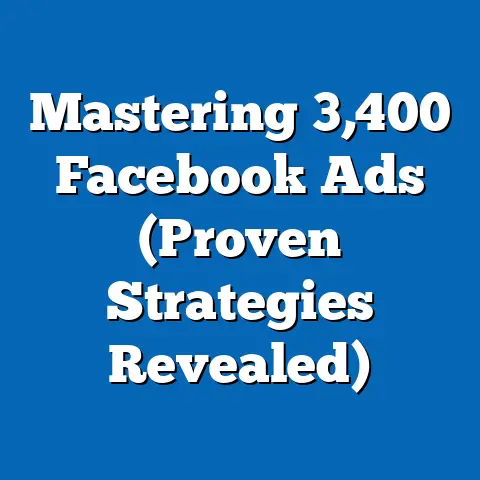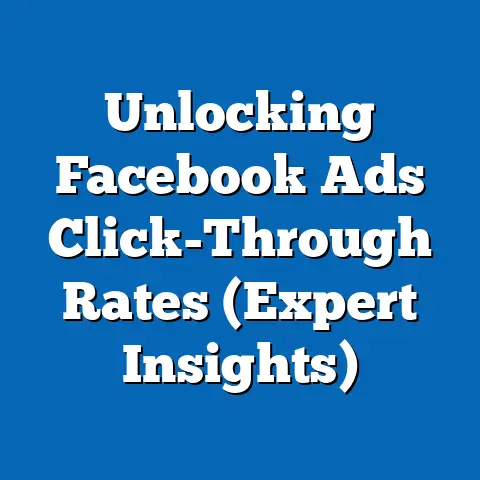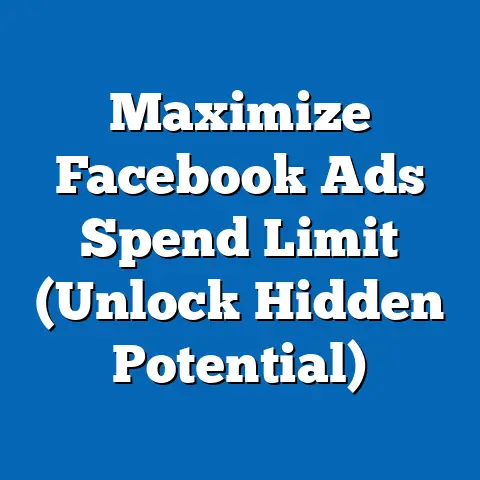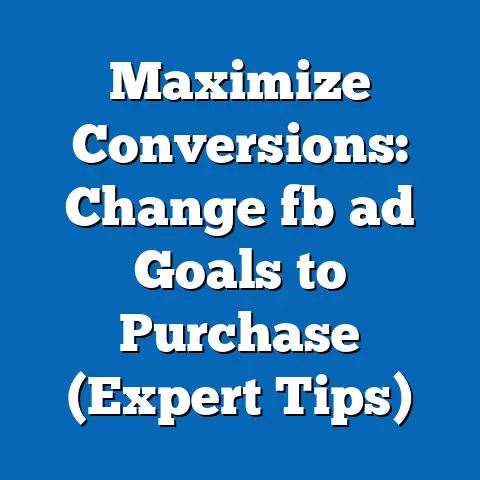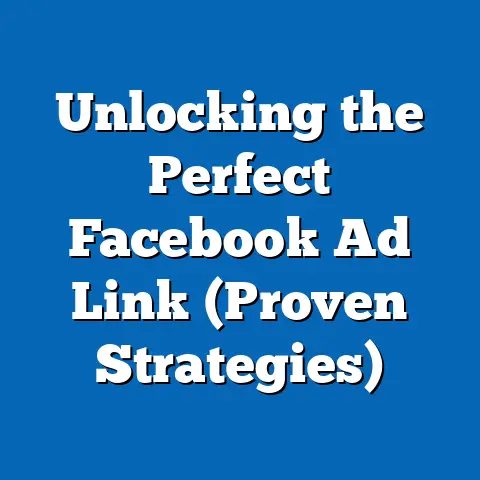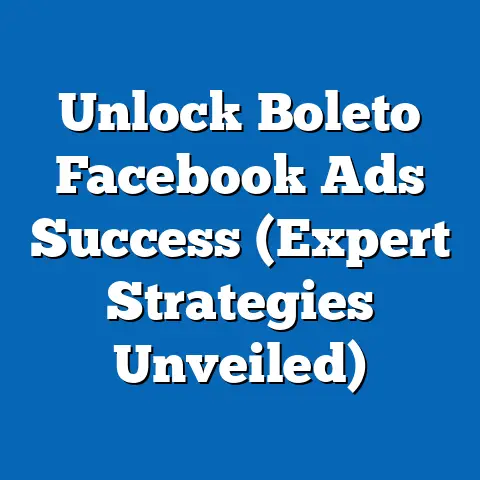Unlock Facebook Ads Without a Page (Game-Changing Strategy)
Imagine waking up each morning not to the grind of a 9-to-5, but to the satisfying chime of new orders rolling in, all thanks to a strategically crafted Facebook ad campaign. Picture your small business finally gaining the traction it deserves, reaching customers you never thought possible, and building a brand that resonates. Or perhaps you’re a non-profit, and you can see your donation numbers skyrocketing as you reach more people with your important message. This isn’t just a pipe dream; it’s a reality that can be unlocked through the power of Facebook advertising.
For years, the traditional route to running Facebook ads involved a Facebook Page. But what if I told you there’s a game-changing strategy that allows you to bypass this requirement, opening up a world of possibilities for those who don’t have, or don’t want to manage, a public Facebook Page? This article isn’t just about a clever workaround; it’s about empowerment. It’s about giving you the tools and knowledge to elevate your life, your business, and your impact through innovative digital marketing. It’s about unlocking Facebook ads without a page and claiming your piece of the digital pie.
I’ve spent years navigating the ever-changing landscape of Facebook advertising, and I’ve seen firsthand how even the smallest tweak can make a massive difference. This particular strategy is something I stumbled upon while working with a client who, for various reasons, didn’t want a public Facebook presence. The results were astounding, and I knew I had to share this knowledge. So, buckle up, because we’re about to dive deep into a game-changing strategy that could revolutionize your marketing efforts.
Section 1: The Traditional Facebook Ads Landscape
Understanding Facebook Ads
Facebook Ads have become an undeniable force in the digital marketing world. With billions of active users, Facebook offers unparalleled reach and targeting capabilities. Businesses, both large and small, leverage Facebook Ads to connect with their ideal customers, drive traffic to their websites, generate leads, and ultimately, boost sales. I’ve seen everything from local bakeries advertising their daily specials to global corporations promoting their latest product launches, all within the Facebook ecosystem.
Traditionally, running Facebook Ads required having a Facebook Page. This Page served as the public face of your business, a hub for engagement, and the anchor point for your ad campaigns. Ads would link back to your Page, allowing users to learn more about your brand, interact with your content, and potentially become loyal customers. The logic seemed straightforward: a Facebook Page establishes credibility and provides a platform for building a community around your brand.
However, this traditional approach presents challenges for some. Maintaining a Facebook Page requires consistent effort, content creation, and community management. For entrepreneurs who are already stretched thin, or for businesses with a limited marketing budget, managing a Facebook Page can feel like an overwhelming task. Furthermore, some businesses may simply not want a public Facebook presence for various strategic or philosophical reasons.
Challenges Faced by Marketers
The conventional requirement of having a Facebook Page to run ads poses significant hurdles for entrepreneurs and small businesses. Without a Page, your reach is inherently limited. You’re essentially excluded from tapping into the vast potential of Facebook’s advertising platform. This limitation can stifle growth, prevent you from connecting with your target audience, and ultimately, impact your bottom line.
I remember working with a startup that had a truly innovative product, but they were struggling to gain traction. They didn’t have the resources to dedicate to managing a Facebook Page, and they felt like they were missing out on a huge opportunity. They told me, “It feels like we’re trying to build a house without a foundation!” That’s exactly how it feels when you’re trying to navigate Facebook advertising without a Page.
The challenge extends beyond just limited reach. Without a Page, you miss out on valuable engagement opportunities. You can’t build a community around your brand, gather feedback from your customers, or leverage social proof to build trust. This lack of engagement can make it harder to convert potential customers into loyal fans.
Furthermore, without a Page, you may struggle to build brand awareness. A Facebook Page provides a central location for users to learn about your business, view your products or services, and understand your brand values. Without this central hub, it can be more challenging to establish a strong brand identity and differentiate yourself from the competition.
Takeaway: The traditional Facebook Ads landscape, with its requirement of having a Facebook Page, presents significant challenges for entrepreneurs and small businesses. Limited reach, lack of engagement, and difficulty building brand awareness can hinder growth and prevent you from connecting with your target audience.
Section 2: The Game-Changing Strategy
Introducing the Concept
Now, let’s get to the exciting part: the game-changing strategy that allows you to unlock Facebook Ads without a Page. This approach leverages the power of Facebook’s Business Manager and Ads Manager to create and run ads that don’t require a public Facebook Page. It’s a bit like discovering a secret back door to a hidden treasure trove.
The core idea is to use Facebook’s Lead Generation ads or Traffic ads and link them directly to your website or landing page, bypassing the need for a Facebook Page altogether. This allows you to focus solely on creating compelling ads that drive results, without the added burden of managing a public social media presence.
This strategy isn’t just a loophole; it’s a legitimate and effective way to leverage Facebook’s advertising platform, particularly for businesses that prioritize direct response marketing or lead generation. It’s about being strategic and focusing your efforts on the activities that deliver the highest ROI.
I’ve seen this strategy work wonders for businesses in various industries, from e-commerce stores to service providers. It’s particularly effective for businesses that have a strong online presence outside of Facebook, such as a well-designed website or a dedicated landing page.
Step-by-Step Guide to Implementing the Strategy
Here’s a detailed, step-by-step guide to implementing this game-changing strategy:
Step 1: Creating a Business Manager Account
The foundation of this strategy is a Facebook Business Manager account. Business Manager is a free tool that allows you to manage your ad accounts, pages, and other business assets in one central location.
- Go to Business.Facebook.com: Navigate to the Facebook Business Manager website.
- Create an Account: Click on the “Create Account” button and follow the prompts to set up your Business Manager account. You’ll need to provide your business name, your name, and your business email address.
- Verify Your Email: After creating your account, you’ll receive a verification email. Click on the link in the email to verify your account.
- Add Your Ad Account: Once your Business Manager account is set up, you’ll need to add your ad account. If you already have an ad account, you can claim it within Business Manager. If you don’t have an ad account, you can create a new one.
- Add People: You can add other people to your Business Manager account and assign them specific roles and permissions. This is useful if you have a team working on your Facebook Ads campaigns.
Step 2: Utilizing Ads Manager
Once you have your Business Manager account set up, you can start using Ads Manager to create and run your ads.
- Navigate to Ads Manager: Within Business Manager, click on the “Ads Manager” icon in the left-hand menu.
- Create a New Campaign: Click on the “Create” button to start a new ad campaign.
-
Choose Your Campaign Objective: This is where the magic happens. Select a campaign objective that aligns with your goals. For this strategy, I recommend choosing either “Lead Generation” or “Traffic.”
- Lead Generation: This objective allows you to collect leads directly within Facebook, without sending users to your website. This is ideal if you want to capture contact information and follow up with potential customers later.
- Traffic: This objective is designed to drive traffic to your website or landing page. This is ideal if you want to send users to a specific page on your website to learn more about your products or services.
- Set Your Budget and Schedule: Define your daily or lifetime budget and choose the dates you want your ad campaign to run.
- Define Your Audience: This is a crucial step. Use Facebook’s targeting options to define your ideal audience based on demographics, interests, behaviors, and more.
- Choose Your Ad Placement: Select the placements where you want your ads to appear. You can choose to show your ads on Facebook, Instagram, Audience Network, and Messenger.
- Create Your Ad: This is where you’ll design your ad creative, including the headline, body text, image or video, and call-to-action button.
- Review and Publish: Review your ad campaign settings and ad creative, and then click on the “Publish” button to launch your campaign.
Choose Your Campaign Objective: This is where the magic happens. Select a campaign objective that aligns with your goals. For this strategy, I recommend choosing either “Lead Generation” or “Traffic.”
- Lead Generation: This objective allows you to collect leads directly within Facebook, without sending users to your website. This is ideal if you want to capture contact information and follow up with potential customers later.
- Traffic: This objective is designed to drive traffic to your website or landing page. This is ideal if you want to send users to a specific page on your website to learn more about your products or services.
- Set Your Budget and Schedule: Define your daily or lifetime budget and choose the dates you want your ad campaign to run.
- Define Your Audience: This is a crucial step. Use Facebook’s targeting options to define your ideal audience based on demographics, interests, behaviors, and more.
- Choose Your Ad Placement: Select the placements where you want your ads to appear. You can choose to show your ads on Facebook, Instagram, Audience Network, and Messenger.
- Create Your Ad: This is where you’ll design your ad creative, including the headline, body text, image or video, and call-to-action button.
- Review and Publish: Review your ad campaign settings and ad creative, and then click on the “Publish” button to launch your campaign.
Step 3: Targeting Your Audience
Effective targeting is essential for the success of any Facebook Ads campaign, especially when you’re running ads without a Page. You need to be laser-focused on reaching the right people with the right message.
- Custom Audiences: Custom Audiences allow you to target people who have already interacted with your business, such as website visitors, email subscribers, or customers. You can upload a list of your existing customers or use the Facebook Pixel to track website visitors and create a Custom Audience based on their behavior.
- Lookalike Audiences: Lookalike Audiences allow you to target people who are similar to your existing customers or website visitors. This is a powerful way to expand your reach and find new potential customers who are likely to be interested in your products or services.
- Detailed Targeting: Facebook’s detailed targeting options allow you to target people based on their demographics, interests, behaviors, and more. This is a great way to narrow down your audience and reach people who are most likely to be interested in your ads.
Step 4: Crafting Compelling Ads
Creating compelling ads is crucial for capturing attention and driving results, especially when you don’t have a Facebook Page to rely on for social proof.
- Headline: Your headline should be attention-grabbing and clearly communicate the value proposition of your offer.
- Body Text: Your body text should provide more details about your offer and explain why people should click on your ad.
- Image or Video: Your image or video should be visually appealing and relevant to your offer. Use high-quality visuals that capture attention and communicate your message effectively.
- Call-to-Action Button: Your call-to-action button should clearly tell people what you want them to do, such as “Learn More,” “Sign Up,” or “Shop Now.”
Takeaway: By leveraging Facebook Business Manager and Ads Manager, you can create and run Facebook Ads without a Page. Choose “Lead Generation” or “Traffic” as your campaign objective, utilize advanced targeting techniques like Custom Audiences and Lookalike Audiences, and craft compelling ad creative that resonates with your target audience.
Section 3: Real-Life Success Stories
To illustrate the effectiveness of this game-changing strategy, let’s explore some real-life success stories:
Case Study 1: An Entrepreneur’s Journey
Sarah, a budding entrepreneur, had a brilliant idea for a subscription box service featuring artisanal coffee beans from around the world. However, she was hesitant to create a Facebook Page because she didn’t have the time or resources to manage it effectively. Instead, she decided to focus on building a strong website and leveraging Facebook Ads without a Page.
Sarah created a series of compelling Lead Generation ads that targeted coffee lovers based on their interests and demographics. Her ads featured stunning photos of exotic coffee beans and highlighted the unique benefits of her subscription service. By collecting leads directly within Facebook, Sarah was able to build a robust email list and nurture potential customers with personalized follow-up messages.
Within a few months, Sarah’s subscription box service had gained significant traction, and she was generating a steady stream of revenue. She proved that it’s possible to build a successful business on Facebook without the traditional requirement of having a Facebook Page.
Case Study 2: A Non-Profit Organization
“Helping Hands,” a non-profit organization dedicated to providing food and shelter to the homeless, faced the challenge of reaching a wider audience and increasing donations. They had a limited marketing budget and didn’t have the resources to manage a Facebook Page.
Instead, they decided to leverage Facebook Ads without a Page to promote their mission and solicit donations. They created a series of emotionally compelling Traffic ads that featured stories of people they had helped and highlighted the impact of their work. These ads linked directly to their donation page on their website.
As a result of their Facebook Ads campaign, “Helping Hands” saw a significant increase in donations and were able to expand their services to help more people in need. They demonstrated the power of Facebook Ads in driving social impact, even without a Facebook Page.
Case Study 3: A Local Business
“The Corner Bistro,” a local restaurant known for its delicious comfort food, wanted to attract more customers and boost foot traffic. They had a website, but they didn’t have a Facebook Page.
They decided to experiment with Facebook Ads without a Page to promote their daily specials and highlight their cozy atmosphere. They created a series of visually appealing Traffic ads that featured mouthwatering photos of their dishes and linked directly to their online menu.
The Corner Bistro saw a noticeable increase in foot traffic and were able to attract new customers who had never heard of their restaurant before. They proved that Facebook Ads can be a powerful tool for driving local business, even without a Facebook Page.
Takeaway: These real-life success stories demonstrate that it’s possible to achieve significant results with Facebook Ads without a Page. Whether you’re an entrepreneur, a non-profit organization, or a local business, this strategy can help you reach your goals and grow your business.
Section 4: Measuring Success and Optimizing Campaigns
Running Facebook Ads without a Page requires a keen focus on data and analytics. You need to track the right metrics, analyze the results, and optimize your campaigns accordingly to ensure you’re getting the best possible ROI.
Key Metrics to Track
Here are some of the most important performance metrics to monitor when running Facebook Ads without a Page:
- Click-Through Rate (CTR): This metric measures the percentage of people who see your ad and click on it. A high CTR indicates that your ad is relevant and engaging to your target audience.
- Conversion Rate: This metric measures the percentage of people who click on your ad and complete a desired action, such as filling out a lead form or making a purchase. A high conversion rate indicates that your ad is effectively driving results.
- Cost Per Click (CPC): This metric measures the average cost you pay for each click on your ad. A low CPC indicates that your ad is efficiently driving traffic to your website or landing page.
- Cost Per Lead (CPL): This metric measures the average cost you pay for each lead you generate. A low CPL indicates that your ad is effectively capturing leads at an affordable price.
- Return on Ad Spend (ROAS): This metric measures the revenue you generate for every dollar you spend on advertising. A high ROAS indicates that your ad campaign is profitable and delivering a positive return on investment.
A/B Testing and Optimization
A/B testing is a crucial part of optimizing your Facebook Ads campaigns. It involves creating multiple versions of your ad and testing them against each other to see which one performs best.
Here are some elements you can A/B test:
- Headline: Test different headlines to see which one is most attention-grabbing and effective at driving clicks.
- Body Text: Test different body text variations to see which one is most persuasive and effective at driving conversions.
- Image or Video: Test different images or videos to see which one is most visually appealing and relevant to your target audience.
- Call-to-Action Button: Test different call-to-action buttons to see which one is most effective at driving desired actions.
- Audience Targeting: Test different audience targeting options to see which one is most effective at reaching your ideal customers.
Iterating Based on Data
The key to successful Facebook Ads campaigns is to continuously iterate based on data. Regularly analyze your performance metrics, identify areas for improvement, and make adjustments to your ad campaigns accordingly.
Here are some strategies for using analytics to iterate and improve your campaigns:
- Identify Underperforming Ads: Identify ads that have a low CTR, conversion rate, or ROAS, and pause or replace them with new variations.
- Optimize Targeting: Refine your audience targeting based on the demographics, interests, and behaviors of the people who are clicking on your ads and converting.
- Improve Ad Creative: Continuously test new headlines, body text, images, and videos to see which ones are most effective at capturing attention and driving results.
- Adjust Bidding: Adjust your bidding strategy to optimize for the lowest CPC, CPL, or ROAS.
Takeaway: Measuring success and optimizing campaigns are crucial for maximizing the ROI of your Facebook Ads. Track key metrics like CTR, conversion rate, CPC, CPL, and ROAS. Utilize A/B testing to refine your ad creative and targeting options. Continuously iterate based on data to improve your campaign performance.
Section 5: Future Trends and Implications
The landscape of Facebook advertising is constantly evolving, and it’s important to stay up-to-date on the latest trends and developments to maintain a competitive edge.
The Evolving Landscape of Facebook Advertising
Facebook is continuously introducing new features and tools for advertisers. Here are some emerging trends to watch:
- AI-Powered Advertising: Facebook is increasingly using artificial intelligence to automate and optimize ad campaigns. AI-powered tools can help you identify the best targeting options, create compelling ad creative, and optimize your bidding strategy.
- Video Advertising: Video advertising continues to grow in popularity. Short-form video content is particularly effective at capturing attention and driving engagement.
- Augmented Reality (AR) Ads: Facebook is experimenting with AR ads that allow users to interact with products and experiences in a virtual environment. This can be a powerful way to showcase your products and create a memorable brand experience.
- Privacy-Focused Advertising: With increasing concerns about data privacy, Facebook is implementing new privacy-focused advertising features. This includes tools that allow users to control the data that is used to target them with ads.
Broader Implications for Digital Marketing
The ability to run Facebook Ads without a Page has broader implications for the future of digital marketing. It empowers businesses of all sizes to leverage the power of Facebook advertising, regardless of their resources or marketing expertise.
This strategy also highlights the importance of focusing on direct response marketing and lead generation. By bypassing the need for a Facebook Page, you can focus solely on creating compelling ads that drive results.
Furthermore, this strategy underscores the importance of having a strong online presence outside of Facebook. A well-designed website or a dedicated landing page is essential for converting potential customers who click on your ads.
Final Thoughts on Embracing Change
In the ever-evolving world of digital marketing, it’s crucial to embrace change and adapt to new strategies and technologies. The ability to run Facebook Ads without a Page is just one example of how the advertising landscape is changing.
By staying informed, experimenting with new approaches, and continuously optimizing your campaigns, you can unlock the full potential of Facebook advertising and achieve your business goals.
Takeaway: The future of Facebook advertising is constantly evolving. Stay up-to-date on the latest trends and developments, embrace new strategies and technologies, and focus on direct response marketing and lead generation.
Conclusion
Unlocking Facebook Ads without a Page is more than just a clever marketing trick; it’s a gateway to a lifestyle upgrade. It’s about taking control of your marketing destiny, reaching your target audience, and achieving your business goals, all without the added burden of managing a public Facebook Page.
Think about it: with this strategy, you can finally launch that side hustle you’ve been dreaming about. You can grow your small business and reach new customers you never thought possible. You can even make a positive impact on the world by promoting your non-profit organization and increasing donations.
The possibilities are endless.
So, what are you waiting for? Take action today and unlock the power of Facebook Ads without a Page. Remember, the ability to market efficiently can lead to both personal and professional growth, ultimately facilitating a life of freedom and success. It’s time to claim your piece of the digital pie and watch your dreams become a reality.

